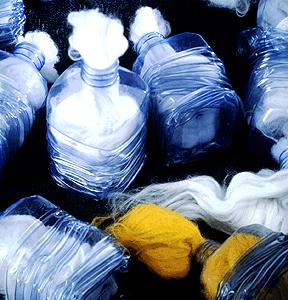 MUTATIONS.//MODE
MUTATIONS.//MODE1960 - 2000
1. april 2000 - 30 july 20000
The Development of Knits
Some exposed models: From a selection of largely eclectic lingerie, we will notice the first bra with elastic straps launched by Warner in 1964 (coll. Warner); coordinated, multicolored, whimsical ensembles from Huit (197 1, coll. Huit) and from Mary Quant (1972-73, Museum of London).
The Transfers of Technology The Years 1975 - 2000 From sports, we will take the omnipresence of elasthanne, an elastic synthetic fiber sold commercially under the name Lycra by Du Pont de Nemours or Dorlastan by Bayer. Marc Audibet proposes, from 1984, leopard-print bodysuits realized in bi-extendible material, in other words, material which stretches in the warp and in the woof. This section also juxtaposes the volume of down with emptiness, found either in an air pocket inserted in the soles of basketball sneakers (Nike Air, 1979), or in the fibers themselves (Adidas, outerwear made with Coolmax hollow polyester fibers, 1996). From the medical world and germproof surgery environments in particular, we find clothing (Boudicca, André Walker) or accessories with a wide variety of qualities: anti-bacterial, auto-massaging, relaxing, hydrating, perfuming, skin tanning or protective... The automobile inspires the most unusual variety of fashion mutations. Paco Rabanne has assembled reflectors taken from bicycles. Thierry Mugler proposes a strapless "Harley Davidson" bra in plexiglas, and a "tire" outfit, whose streamlined and dynamic allure feed the imagination. Lastly, JeanCharles de Castelbajac, in the manner of a street signal, borrows a reflective material called Reflexite. Aeronautics and aerospace science research has always aroused the interest of fashion designers. On 21 July 1969, astronauts Edwin "Buzz" Aldrin and Neil Armstrong wore uniforms composed of 21 layers of high-tech tissues, 20 of which were synthetic, on the moon's surface. Elisabeth de Senneville re-uses an engine-insulating tissue. In 1998, Damart commercialized an American technology of phase-changing microcapsules (Outlast@) in France. These microcapsules contain chemical elements, capable of changing states, which can store ambient heat by liquefying themselves and release it by re-solidifying themselves. The tissue therefore heats up without an external energy source. Military equipment is far from being the least exploited area by the fashion world. We already know the trench coat, the safari jacket, and others. The exhibition points out the theme of protection in two ways: camouflage (evening dresses by Valentino, Koji Tatsuno, and Sonja Nuttal ... ), and the use of highly resistant fibers like Kevlar (Du Pont de Nemours) in articles such as bulletproof vests. A textile installation by the artist Sheila Hicks, "Back From The Front", completes this section.
Recyclables
Fig.: Charles Dubourg, pull over, 1998. |